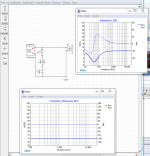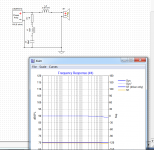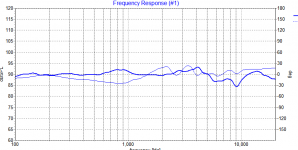Hey there!
I´m experiencing a problem with Xsim in my laptop. Operation seems just fine, but trying to open a saved project gives a error message, ...
Can you attach that .dxo file to be examined by others?
According to this site - Points or Commas? Decimal Separators By Country | SmartickI described a solution here:
XSim free crossover designer
Argentines use a decimal comma.
That would be a good idea. Those of us with XSim on Win10 could try to open it.
works flawlessly on Windows 10 Pro
a rhetorical question. do you measure the impedance of the driver inside the enclosure to use it in XSIM? or the impedance in the datasheet will be adequate?
Xsim has really lots of useful functionality but I have a problem with notch filters - as in the attachment I added a notch and there are changes to the impedance curve but no impact on the FR. Does it mean XSim does not handle notch filters or it works in some other way ?
And one more question - do you know and can suggest an online calculator that calculates resonance filters to correct speaker SPL irregularities - both in plus and in minus ? I am thinking about something that you enter -3dB Freq left and right and peak level either +dB or -dB ?
I have googled for some time but with no good results, the only partial functionality here:
Parallel Notch Filter Designer / Calculator
Best, Pawel
And one more question - do you know and can suggest an online calculator that calculates resonance filters to correct speaker SPL irregularities - both in plus and in minus ? I am thinking about something that you enter -3dB Freq left and right and peak level either +dB or -dB ?
I have googled for some time but with no good results, the only partial functionality here:
Parallel Notch Filter Designer / Calculator
Best, Pawel
Attachments
Xsim is correct, you need to have a part of the crossover with which this filter can divide the signal. This might be as simple as one series component, something you might be using in the crossover anyway.
I notice you are trying to notch below 100Hz, if you describe all the things you want to do with this driver, we might be able to suggest a topology..
I notice you are trying to notch below 100Hz, if you describe all the things you want to do with this driver, we might be able to suggest a topology..
Xsim is correct, you need to have a part of the crossover with which this filter can divide the signal. This might be as simple as one series component, something you might be using in the crossover anyway.
I notice you are trying to notch below 100Hz, if you describe all the things you want to do with this driver, we might be able to suggest a topology..
Thanks Allen, makes sense. Can you suggest then what kind of neutral addition I could make to simulate and see a notch filter FR ? Or this is not possible to get an isolated FR to check what XSim thinks of my RLC ?
An e.g. a few Ohm resistor in series does not help.
{Edit] On a second thought, however, I would expect that the filter shares and impacts the signal in relation to the speaker itself modelled as a resistor ? I would normally expect that at the resonance frequency the filter takes away the signal from the speaker that resists more the current. So the speaker should show a dip at this frequency as then the flow does not go through it, shouldn't' it ?
Last edited:
You can set it up to just demonstrate with resistive driver and sufficient series resistor, but the real effect of the notch depends on the rest of the crossover.
Here is the usual example.. The series element for a woofer is an inductor. This has some series impedance where you want to notch a breakup mode, so it works. Another example is a series capacitor, which has sufficient reactance near where a notch filter is used at tweeter resonance.
In other cases the notch filter can be moved in series with the driver instead, where you use a parallel style filter (in series with the driver).
Here is the usual example.. The series element for a woofer is an inductor. This has some series impedance where you want to notch a breakup mode, so it works. Another example is a series capacitor, which has sufficient reactance near where a notch filter is used at tweeter resonance.
In other cases the notch filter can be moved in series with the driver instead, where you use a parallel style filter (in series with the driver).
You are putting the series resonant network across the power amplifier output. The amplifier in XSim has an output impedance of a few thousandths of an ohm, so it can drive about any realistic impedance without its output voltage dropping visibly. Its output current of course goes sky high, but that current through the series network isn't going through the driver so it doesn't show. Put the resistor (or other impedance) between the power amplifier and the series resonant notch to see it cut the voltage down. It's not a notch if there's no series impedance to pull down off of, it's just a current sucker.
Thanks folks for the tips and a practical refresher in EE, I actually quite appreciate it 
So I would also appreciate your comments how you would approach linearity deviations in my xover design, FR attached.
I would be more happy if I could:
1) reduce the baffle step-related peak at 600Hz - 1k,
2) reduce the 4k peak
3) boost a bit the 4k-9k dips coming from the Seas coax tweeter FR.
I thought about notch filters but struggled to find a calculator for that. Or maybe you can suggest sth different ?
So I would also appreciate your comments how you would approach linearity deviations in my xover design, FR attached.
I would be more happy if I could:
1) reduce the baffle step-related peak at 600Hz - 1k,
2) reduce the 4k peak
3) boost a bit the 4k-9k dips coming from the Seas coax tweeter FR.
I thought about notch filters but struggled to find a calculator for that. Or maybe you can suggest sth different ?
Attachments
- Home
- Design & Build
- Software Tools
- XSim free crossover designer


